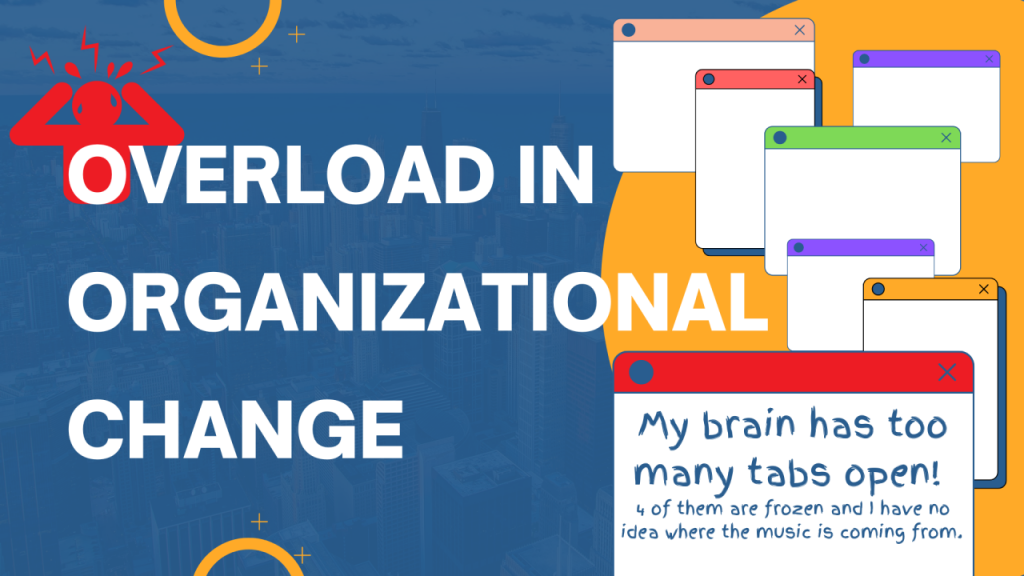
A recent post by the inspiring team behind Corporate Rebels emphasized a common challenge in today’s workplaces: the cognitive overload from all that happens around you and what it does to your productivity. While it made me think about myself (and my browser, just to stay with the metaphor…), I also found it to pose a critical question to change managers: How many tabs are open in your target groups’ heads? This image serves as a powerful reminder that in the midst of driving transformation, the mental and emotional bandwidth of our teams is often stretched thin.
Understanding Cognitive Overload in Change Management
In an era where change is constant, employees frequently juggle numerous projects and change initiatives, each competing for their attention and energy. This “tab overload” can lead to decreased productivity, increased stress, and a higher likelihood of resistance to new changes. Cognitive Load Theory suggests that people have a limited capacity in their working memory to process information, and when overwhelmed, their ability to effectively process and retain information is compromised.
Scientific Insights on Task Management
Research indicates several downsides to managing parallel projects:
- Task Switching Costs: Psychological studies show that switching between tasks can lead to significant time loss and an increase in errors, as the brain expends energy realigning to each task’s context.
- Reduced Productivity and Quality: Multitasking and high task-switching frequencies can decrease productivity. Several studies found that heavy multitaskers are less effective at completing tasks than those who focus on one task at a time. In fact, research found that workers who task switch take as much as 50% more time to complete a task and are 40% less productive.
- Increased Stress: Juggling multiple projects not only impacts productivity but also increases stress levels, which can lead to quicker mental fatigue and potential burnout.
Consider the scenario in a tech company where employees were simultaneously navigating software upgrades, shifts in management, a rebranding initiative, and a restructuring of administrative functions to a Global Business Services model. Understanding and complying with all these initiatives happens naturally on top of employees’ regular workload.
While that sounds like many changes at the same time, it may well be the norm.
“In 2022, the average employee experienced 10 planned enterprise changes — such as a restructure to achieve efficiencies, a culture transformation to unlock new ways of working, or the replacement of a legacy tech system — up from two in 2016, according to Gartner research.” Harvard Business Review
So what can you do?
Strategies to Manage Change Overload
- Prioritization of Initiatives: Just as we might prioritize browser tabs to keep open, organizations must prioritize change initiatives. This involves aligning changes with strategic objectives and deferring or deprioritizing those that are less critical, ensuring that employees are not overwhelmed. Unfortunately this may lead to an honest assessment of the status quo and consequently some very serious decisions (including curbing the one or the other management ambition…).
- Streamlined Communication: Clear and concise communication can help minimize cognitive load. This means delivering messages that are direct and easy to digest, and consolidating communication channels to reduce the noise and confusion that multiple messages can create.
- Employee Support and Resources: Providing adequate support, such as training and resources, can help employees manage change more effectively. Additionally, implementing tools for better time management and stress reduction can aid in managing the mental load.
If you are interested in more ideas, especially how storytelling and finding the “red thread” help your employees navigate parallel changes effectively, take a look at my speech at Voices 2023 (in German with English subtitles available):
The takeaway? The metaphor of closing unnecessary browser tabs to optimize performance holds true in managing organizational change. By being mindful of the number and impact of change initiatives active at any given time, we can help our teams maintain their focus and well-being. As change managers, it is our responsibility to not only drive change but also ensure it is digestible and manageable for those who are expected to embrace it.
Now I’m curious to learn from you: How do you handle the challenge of multiple simultaneous changes? What strategies have you found effective in helping your team manage their ‘open tabs’? Share your experiences and let’s discuss ways to support our teams better during complex transformations.
#ChangeManagement #OrganizationalChange #EmployeeWellbeing #Leadership #BusinessTransformation
This is a copy of the same post on my LinkedIn blog. To comment and join the discussion on this topic switch to LinkedIn. Follow me for regular updates and blog articles: https://www.linkedin.com/in/drnilskoenig/
